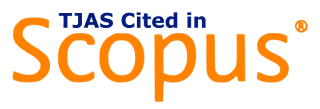The performance of Chlorella vulgaris growth on mass-scale cultivation
Abstract
Keywords
Full Text:
PDFReferences
APHA. (1998). Standard Methods for the Examination of Water and Wastewater. 20th Edn, APHA, AWWA and WPCF, Washington.
Aprilliyanti, S., Soeprobowati, T. R., & Yulianto, B. (2016). Hubungan kemelimpahan Chlorella sp dengan kualitas lingkungan perairan pada skala semi masal di BBPBAP Jepara. Jurnal Ilmu Lingkungan, 14(2), 77-81. https://www.neliti.com/publications/101625/hubungan-kemelimpahan-chlorella-sp-dengan-kualitas-lingkungan-perairan-pada-skal.
Becker, W. (1994). Mikroalgae: Biotechnology and Microbiology. Cambridge University Press (112-146). https://books.google.co.id/books?hl=id&lr=&id=KAKx4I7NWEYC&oi=fnd&pg=PP299&dq=Microalgae:+Biotechnology+and+Microbiology&ots=037tSNOVdN&sig=JebVxAWPB4zD7okEopCkIDSBko&redir_esc=y#v=onepage&q=Microalgae%3A%20Biotechnology%20and%20Microbiology&f=false.
Boroh, R., Litaay, M., Umar, M. R., & Ambeng. (2019). Pertumbuhan Chlorella sp. pada beberapa kombinasi media kultur. Jurnal Biologi Makassar, 4(2), 129-137. https://journal.unhas.ac.id/index.php/bioma/article/view/6759.
Boyd, C. E. (1990). Water Quality in Ponds for Aquaculture. Experiment Station Alabama (482 hlm). https://agris.fao.org/agris-search/search.do?recordID=US19930090347.
Chia, M. A., Lombardi, A. T., & Melao, M. D. G. G. (2013). Growth and biochemical composition of Chlorella vulgaris in different growth media. Anais da Academia Brasileira de Ciencias, 85(4), 1427-1438. https://www.scielo.br/pdf/aabc/v85n4/0001-3765-aabc-00-00-6613.pdf.
Choudhury, A. K., & Pal, R. (2010). Phytoplankton and nutrient dynamics of shallow coastal stations at Bay of Bengal, Eastern Indian coast. Aquatic Ecology, 44, 55-71. https://link.springer.com/article/10.1007/s10452-009-9252-9.
Creswell, L. (2010). Phytoplankton culture for aquaculture feed. Southern Regional Aquaculture Center, 1-13. http://fisheries.tamu.edu/files/2013/09/SRAC-Publication-No.-5004-Phytoplankton-Culture-for-Aquaculture-Feed.pdf.
Daliry, S., Hallajisani, A., Roshandeh, J. M., Nouri, H., & Golzary, A. (2017). Investigation of optimal condition for Chlorella vulgaris microalgae growth. Global Journal of Environmental Science and Management, 3(2), 217-230. https://www.sid.ir/en/journal/ViewPaper.aspx?id=525847.
Effendi, H. (2003). Telaah Kualitas Air bagi Pengelolaan Sumberdaya dan Lingkungan Perairan. Penerbit Kanisius.
Hadiyanto., & Azim, M. (2012). Mikroalga Sumber Pangan dan Energi Masa Depan. Semarang: UPT UNDIP Press. http://eprints.undip.ac.id/48607/1/Buku_Mikroalga___B5.pdf.
Junda, M. (2018). Development of intensive shrimp farming, Litopenaeus vannamei in land-based ponds: production and management. Journal of Physics: Conference Series, 1028, 1-6. https://iopscience.iop.org/article/10.1088/1742-6596/1028/1/012020/meta.
Kandi, I. W. (2018). Teknik kultur fitoplankton Chlorella vulgaris skala laboratorium sebagai pakan alami Daphnia sp. di Balai Pengembangan Teknologi Perikanan Budidaya (BPTPB) Cangkringan, Sleman, Yogyakarta. Universitas Airlangga Repository . http://repository.unair.ac.id/78502/.
Maresi, S. R. P., Priyanti., & Yunita, E. (2015). Fitoplankton sebagai bioindikator saprobitas perairan di Situ Bulakan Kota Tangerang. Al-Kauniyah Jurnal Biologi, 8(2), 113-122. http://journal.uinjkt.ac.id/index.php/kauniyah/article/view/2697.
Marshito, I. (2012). Produktifitas primer dan struktur komunitas pada berbagai substrat perifiton pada berbagai substrat buatan di Sungai Kromong Pacet Mojokerto [Skripsi program studi S-1 Biologi Departemen Biologi, Universitas Airlangga Surabaya]. Universitas Airlangga Repository. http://repository.unair.ac.id/25672/.
Novianti, T., Zainuri, M., & Widowati, I. (2017). Studi tentang pertumbuhan mikroalga Chlorella vulgaris yang dikultivasi berdasarkan sumber cahaya yang berbeda. MANGIFERA EDU: Jurnal Biologi and Pendidikan Biologi, 1(2), 1-8. https://scholar.google.co.id/scholar?hl=id&as_sdt=0%2C5&q=Studi+tentang+pertumbuhan+mikroalga+Chlorella+vulgaris+yang+dikultivasi+berdasarkan+sumber+cahaya+yang+berbeda&btnG=.
Nurlaili, F. R., Hendrawan, Y., & Nugroho, W. A. (2015). Pengaruh dosis penambahan bakteri (Azospirillum sp.) terhadap kelimpahan populasi mikroalga (Chlorella sp.) pada media kultur limbah cair biogas (setelah proses anaerob). Jurnal Keteknikan Pertanian Tropis dan Biosistem, 3(2), 121-126. https://jkptb.ub.ac.id/index.php/jkptb/article/view/265.
Persada, A. Y., Navia, Z. I., Saputri, A., Putri, K. A., & Fajar, B. A. (2019). Inventaris jenis fitoplankton di Pulau Pusong, Langsa, Aceh. Elkawine: Journal of Islamic Science and Technology, 5(1), 67-75. https://core.ac.uk/download/pdf/228448775.pdf.
Prasetio, H., Purwiyanto, A. I. S., & Agussalim, A. 2016. Analisis logam berat timbal (Pb) dan tembaga (Cu) dalam plankton di Muara Banyuasin Provinsi Sumatera Selatan. MASPARI JOURNAL, 8(2), 73-82.
Prayogo, I., & Arifin, M. (2015). Teknik kultur pakan alami Chlorella sp. dan Rotifera sp. skala massal dan manajemen pemberian pakan alami pada larva kerapu cantang. Samakia: Jurnal Ilmu Perikanan, 6(2), 125-134. https://core.ac.uk/download/pdf/276635732.pdf.
Romdhane, F. H., Zheng, X., Jaouen, P., Pruvost, J., Grizeau, D., Croue, J. P., & Bourseau, P. (2013). The culture of Chlorella vulgaris in a recycled supernatant: effects on biomass production and medium quality. Bioresource Technology, 132, 285-292. https://www.sciencedirect.com/science/article/pii/S0960852413000485?casa_token=xBc3bnMDpYAAAAA:EUgSdSszJDDiC_xwYUqMEtdcuiYMn2sfpZEkAUA_DUgC0yaWDXlSNvPL_fdHI0_wrVR-aW_H0Q4.
Rumanti, M., Rudiyanti, S., & Suparjo, M. N. (2014). Hubungan antara kandungan nitrat dan fosfat dengan kelimpahan fitoplankton di Sungai Bremi Kabupaten Pekalongan. DIPONEGORO JOURNAL OF MAQUARES, 3(1), 168-176. https://ejournal3.undip.ac.id/index.php/maquares/article/view/4434.
Salgueiro, J. L., Perez, L., Maceiras, R., Sanchez, A., & Cancela, A. (2016). Bioremediation of wastewater using Chlorella vulgaris microalgae: phosphorus and organic matter. International Journal of Environmental Research, 10(3), 465-470. https://ijer.ut.ac.ir/article_58766.html.
Salman, J. M., Hadi, S. J., & Mutaer, A. A. (2013). Spatial and temporal distribution of phytoplankton and some related physical and chemical properties in Al-Abasia River (Euphrates), Iraq. International Journal of Geology, Earth & Environmental Sciences, 3(3), 155-169. http://www.uobabylon.edu.iq/eprints/publication_1_8546_416.pdf.
Widayat., Philia, J., & Wibisono, J. (2018). Cultivation of microalgae Chlorella sp on fresh water and waste water of tofu industry. E3S Web of Conferences, 31, 04009. https://www.e3s-conferences.org/articles/e3sconf/abs/2018/06/e3sconf_icenis2018_04009/e3sconf_icenis2018_04009.html.
Winder, M., & Sommer, U. (2012). Phytoplankton response to a changing climate. Hydrobiologia, 698, 5-16. https://link.springer.com/article/10.1007/s10750-012-1149-2.
DOI: https://doi.org/10.37905/tjas.v1i2.8123 ';

Tomini Journal of Aquatic Science is licensed under a Creative Commons Attribution 4.0 International License.










